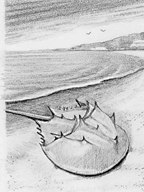 |
Earth Journal by Gary Pendleton |
Horseshoe Crabs
Ancient wonders of the world appear on moonlit beaches
Beneath the late spring full moon, a carpet runner of light reflects on the surface of the Bay. The sky is clear; the beach is moon-lit. Male horseshoe crabs have been waiting weeks for this moment. The recently arrived female crabs have shown their readiness by releasing a pheromone-laced fluid in the water. Drawn by the powerful lure of the pheromone, the males seek out the females with their primitive eyes.
On sandy beaches from the Yucatan in Mexico in the south all the way north to Maine, when the moon is full and temperatures turn warm, horseshoe crabs emerge from deep waters to mate and lay eggs in the sand. The Delaware Bay is famous for its huge population of horseshoe crabs, but the Chesapeake is also an important area for this ancient and ecologically important form of life.
Horseshoe crabs are very different from the more famous symbol of the Chesapeake, the blue crab. In a real sense, horseshoe crabs are not crabs at all but related to spiders. In the fossil record, they first appear during the distant Paleozoic era, 570 to 230 million years ago, give or take a couple of weeks. They have not evolved much since. Their primitive nature has had important implications for medical science and helped one scientist earn a Nobel Prize.
In 1967, Dr. Haldan Hartlanes’ research on the primitive and simple eyes of the horseshoe crab led to breakthrough understandings of how the much more complex eyes of humans convert visual stimulation into images. For this he became a Nobel laureate.
Writing Medicine Quest, ethnobotanist Mark Plotkin called horseshoe crabs “one of the most medically useful animals ever studied.” Research at the Woods Hole Marine Biological Laboratory revealed that the crab’s blood readily coagulates in the presence of some bacterial toxins and diseases. This finding led to the development of an effective chemical test to determine harmful impurities in pharmaceutical products.
Horseshoe crabs play a vitally important ecological role. Many species of shore birds — sandpipers, dunlin, turnstones and other long distance migrants — time their spring arrival on mid-Atlantic beaches to coincide with horseshoe crab mating. Delaware Bay hosts an amazing confluence of crabs and shorebirds.
Individual female crabs deposit upward of 90,000 eggs per season. Of these, just 10 or fewer eggs will survive. The excess eggs provide desperately needed food for the travel-weary wading birds, many bound for as far as the northern tundra.
Threats to a healthy population of horseshoe crabs — among them development, pollution and global warming — also threaten these birds, which would have a difficult time surviving, let alone completing their migratory routes, without eggs to feed on. A collapse of the bird populations would likely cause additional ecological unraveling on their summer and winter grounds as well as points in between.
The dramatic and surprising story of the horseshoe crab and the shore birds beautifully illustrates how the fates of creatures on earth are linked in elegant and complex ways. We depend on our environment not just for food but also for medicine, wonder and even inspiration.